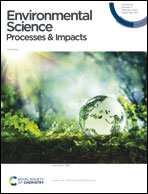Abiotic reduction of 3-nitro-1,2,4-triazol-5-one (NTO) and other munitions constituents by wood-derived biochar through its rechargeable electron storage capacity†
Abstract
The environmental fate of 3-nitro-1,2,4-triazol-5-one (NTO) and other insensitive munitions constituents (MCs) is of significant concern due to their high water solubility and mobility relative to legacy MCs. Plant-based biochars have been shown to possess a considerable electron storage capacity (ESC), which enables them to undergo reversible electron transfer reactions. We hypothesized biochar can act as a rechargeable electron donor to effect abiotic reduction of MCs repeatedly through its ESC. To test this hypothesis, MC reduction experiments were performed using wood-derived biochars that were oxidized with dissolved oxygen or reduced with dithionite. Removal of aqueous NTO, an anion at circumneutral pH, by oxidized biochar was minimal and occurred through reversible adsorption. In contrast, NTO removal by reduced biochar was much more pronounced and occurred predominantly through reduction, with concomitant formation of 3-amino-1,2,4-triazol-5-one (ATO). Mass balance and electron recovery with ferricyanide further showed that (1) the amount of NTO reduced to ATO was relatively constant (85–100 μmol per gram of biochar) at pH 6–10; (2) the fraction of biochar ESC reactive toward NTO was ca. 30% of that toward ferricyanide; (3) the NTO-reactive fraction of the ESC was regenerable over multiple redox cycles. We also evaluated biochar transformation of other MCs, including nitroguanidine (NQ), 2,4-dinitroanisole (DNAN), and hexahydro-1,3,5-trinitro-1,3,5-triazine (RDX). While mass and electron balances could not be established due to sorption, DNAN and RDX reduction by reduced biochar was confirmed via detection of multiple reduction products. In contrast, NQ was not reduced under any of the conditions tested. This study is the first demonstration of organic contaminant degradation through biochar's rechargeable ESC. Our results indicate biochar is a regenerable electron storage medium and sorbent that can remove MCs from water through concurrent reduction and sorption, and is thus potentially useful for pollution control and remediation at military facilities.

- This article is part of the themed collection: Contaminant remediation and fate


 Please wait while we load your content...
Please wait while we load your content...